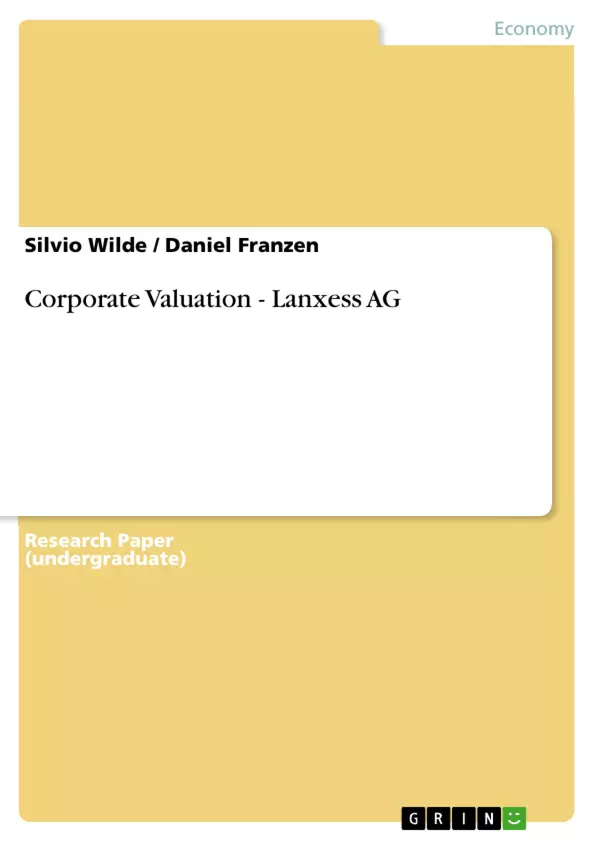The main scope of this assignment is the valuation of the Lanxess AG a German based chemistry corporation, with about 14,400 employees and annual sales of about 5.05 billion EUR. The core activities of Lanxess AG are specialty chemicals, polymers and intermediates, including rubber chemicals, material protection products, ion exchange resins, inorganic pigments, semi-crystalline products and fine chemicals.
The authors have described the two enterprise evaluation methods – the DCF-approach and the multiplier method – with its advantages and disadvantages in practical application. For the corporate evaluation of Lanxess AG, the authors based the calculation on those two most common global evaluation approaches. The DCF method estimates the value of a company by discounting expected cash flows in the future or determined period of time, similar to the value of an investment. For the assessment of the company value, the entity and equity DCF method with an assumed constant growth rate of 3 percent has been applied. For the validation of the calculated DCF corporate values the multiplier method was conducted as second evaluation method based on EBIT-, EBITDA-, Price-Cash Flow-, Price-Earnings, and revenue ratios. For the necessary peer-group, the authors selected six appropriate global competitors: Arkema, BASF, Clariant, DSM, Huntsman and Rhodia. The different evaluation methods lead to various enterprise values of Lanxess AG with a bandwidth of evaluated results between 1.50 billion EUR and the value of 17.98 billion EUR. The DCF-approach results in values from 3.81 billion EUR to 5.81 billion EUR. For the multiplier method there have been calculated enterprise values between 1.5 billion EUR and 17.98 billion EUR. The overall median enterprise value of 3.09 billion EUR compared to the market capitalization of Lanxess AG with 2.19 billion EUR nearly fits into the proposed evaluation strategy but appears undervalued.
Each of the described and applied methods has its own validity because of the specific underlying assumptions. Therefore it is not surprising that there a range and difference in the calculated enterprise value for Lanxess AG.
The team of this evaluation project for Lanxess AG is satisfied with the results by the given information and data quality. The results confirm that the potential investor should analyse Lanxess AG in detail with proposed various functional due diligences.
Inhaltsverzeichnis (Table of Contents)
- Executive Summary
- Table of Content
- List of Abbreviations
- List of Figures
- List of Formulas
- List of Tables
- List of Appendices
- Introduction
- Preface/Problem Description
- Objectives
- Scope and Structure of Work
- Corporate Valuation - History and Drivers
- Preface
- Basic Valuation Principles
- Discounted Cash Flow Methods
- Entity Method
- Equity Method
- Conclusion of the DCF Method
- Multiplier Method
- Introduction to the Multiplier Method
- Methodology of the Multiplier Method
- Conclusion of the Multiplier Method
- Summary
- Company Analysis: Lanxess AG
- Preface
- History of Lanxess AG
- Product History
- Market History
- Customer and Sales Analysis
- Strategic Alliances/Partnerships
- Assessment of Earnings
- Summary
- Information Baseline and Quality
- Preface
- Financial Projections for Lanxess AG
- Assessment of Available Data and Data Quality
- Cash Flow Calculation for Lanxess AG
- WACC Calculation for Lanxess AG
- Analysis and Derivation of Peer Group
- Summary
- Valuation
- Preface
- DCF Method
- Multiplier Method
- Arkema
- BASF
- Clariant
- DSM
- Huntsman
- Rhodia
- Actual Calculation of Multiplier Method
- Results of Both Evaluation Methods/Summary
- Conclusion
- Theoretical/Practical Summary
- Recommendation
- Future Research Direction
Zielsetzung und Themenschwerpunkte (Objectives and Key Themes)
This assignment focuses on the valuation of the German-based chemical corporation, Lanxess AG. The authors aim to assess the company's value through two primary evaluation methods: the discounted cash flow (DCF) method and the multiplier method. This study analyzes the advantages and disadvantages of each method in practical application. The key themes of the work include: * **Corporate valuation methodology**: Applying and contrasting the DCF and multiplier methods to evaluate Lanxess AG. * **Financial analysis**: Analyzing Lanxess AG's financial performance, including cash flow, WACC, and financial projections. * **Industry analysis**: Identifying and assessing the company's competitors and the broader chemical industry landscape. * **Peer group analysis**: Selecting appropriate companies for comparison and using their financial data in the multiplier method. * **Company analysis**: Understanding Lanxess AG's history, products, market, and strategic alliances.Zusammenfassung der Kapitel (Chapter Summaries)
- Introduction: The introduction outlines the objective and scope of the work, which focuses on the valuation of Lanxess AG. It highlights the specific methods employed, namely the DCF and multiplier approaches.
- Corporate Valuation: This section explores the historical context and foundational principles of corporate valuation, including a comprehensive explanation of the DCF method. It delves into both entity and equity DCF approaches and outlines the advantages and disadvantages of the method.
- Company Analysis: This chapter examines Lanxess AG, providing details on its history, product line, market position, customer base, strategic partnerships, and earnings performance.
- Information Baseline and Quality: This section focuses on the data used for the valuation, including financial projections, data quality assessment, and calculation of cash flows and WACC. It also analyzes the selection of a relevant peer group for the multiplier method.
- Valuation: This chapter presents the valuation results based on both the DCF and multiplier methods. It includes a detailed analysis of Lanxess AG's value through various valuation techniques, utilizing data from both the company itself and its competitors.
Schlüsselwörter (Keywords)
The key concepts and terms within this text are: corporate valuation, discounted cash flow (DCF), multiplier method, Lanxess AG, chemical industry, financial analysis, peer group analysis, and company analysis. This study examines the application of various methods to evaluate the value of a company within the specific context of the chemical industry, focusing on Lanxess AG as a case study.- Quote paper
- Silvio Wilde (Author), Daniel Franzen (Author), 2011, Corporate Valuation - Lanxess AG, Munich, GRIN Verlag, https://www.grin.com/document/211110



